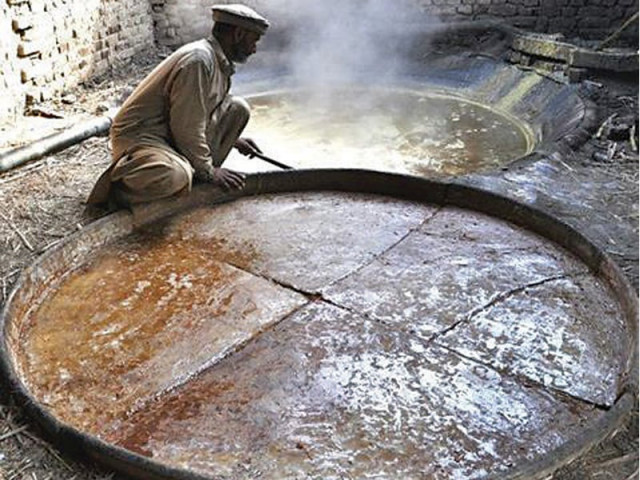
Pakistan, as an agricultural economy, has crops for every season. Winter starts around mid-November and with it begins the harvest of sugarcane. Locals in Charsadda have a centuries-old tradition of making sugar, dating back before the invention of modern mills.
Gurh (jaggery) is produced in old-school mills called ganhai. As a substitute for refined sugar, this presumably pure delicacy is found throughout rural areas.
A lengthy procedure turns ordinary sugarcane into this raw form of sugar; often a key ingredient in kahwa, and many other treats. It is also mixed with dry fruits and served as a delicacy.
Three steps to a sugar high
Jansher Khan, a farmer in Shabqadar, walked The Express Tribune through the process of making gurh. Breaking it down into three stages, he says the first is the harvesting of the crop. According to Jansher, this is always a collective task, colloquially known as watt by workers, which requires manpower. After laborious fieldwork, the farmers transport the cane to the mills for the
second step.

The sugarcane is then crushed at the ganhai. This kind of mill was traditionally powered by oxen or buffaloes but in recent times the animals have been replaced by diesel generators, explained Jansher.
After sugarcane juice is extracted, it is sent for further processing while the waste product (pog) is dried for use as firewood in the next cooking. The two workers who crush the cane are known as ‘perh mar’ in Pashto.
In the third and final stage, the syrup is poured into huge cauldrons and is cooked on a slow flame by the fire-keeper, or ‘jok mar’. After three hours the syrup turns reddish-brown and another worker, called the ‘gurhi’, transfers the sugar to a mud plate to let it cool. When the mixture becomes semi-solid, farmers collectively break it into small pieces and so gurh is ready for use, said Jansher.
The cost of sweetness
According to local trader Riaz Khan, gurh produced locally is of a comparatively higher price than refined sugar. He attributed the cost to the elbow grease used to achieve the purity and taste of the sweetener.
Gurh is also exported to Afghanistan. Nowadays, the price of gurh is Rs100 per kilogramme (kg) in the local market as compared to Rs60 per kg for refined sugar, shared Riaz.
The sweetener can act as a good digestive as it is meant to be free of all chemicals, explained local doctor Ranbeer Singh. However, there have been cases where the gurh turned out to be poisonous –an eventuality if certain chemicals are added – which is why locals avoid it, stated Singh.
Although Charsadda and Mardan are famous for the cultivation of sugarcane, gurh produced in Charsadda villages on the banks of the Swat River is perhaps the most famous. However, this treat does not come cheap, and is of an even higher price than gurh from other parts of the province.
Fall in production
The production of gurh in these districts suffered after the floods in 2010 as most of the fertile land was washed away. The irrigation system in Shabqadar was also destroyed and has still not been rebuilt completely.
“The cultivation of sugarcane requires an abundant water supply,” said Hissadar Khan, a local farmer. “Due to the non-availability of water, production levels in the region are at a low.” Hissadar cited the increase in costs of fertilisers, insecticides, pesticides and
other agricultural necessities as another reason.
Published in The Express Tribune, November 18th, 2013.












COMMENTS
Comments are moderated and generally will be posted if they are on-topic and not abusive.
For more information, please see our Comments FAQ